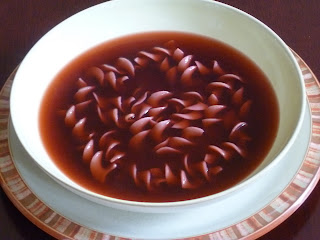Wszystkiego Najlepszego na Boze Narodzenie (Merry Christmas)!
Our traditional Christmas Eve supper is in a few days. I’ve been seeing recently the musings of several Polish American writers, discussing Wigilia traditions in great depth and talking about history, meanings and significances of all the little details and nuances. Those writings were interesting but not so practical for most of us. Over time and several generations removed from the old country, those traditions become less rigid and become somewhat adapted to modern values and cultural comfort zone. Yet, it is the responsibility of the family leaders to not let go of the traditions completely. When I was young, we faithfully followed most of the big ones...starting Wigilia at the light of the first star, sharing the wafer (oplatek), and setting an extra place at the table for the wayfaring stranger, and so on. This year, with our young granddaughter seated at the table, the practicality of regularly scheduled meal times and bed times get a higher priority than waiting for the first star to come out. Not everyone at our table eats fish. But no one will be wearing jeans or flip flops, because after all Wigilia is special and only comes once a year. We still make our wishes for each other with the sharing of a wafer from Poland. We’ve gotten away from some of the traditional dishes that are more time consuming, but we each have something on the menu that is special and beloved. Each of the dishes we enjoy for Wigilia is in our book.
• Crepes with Sauerkraut & Mushrooms
• Classic Beet Soup
• Baked Fish With Mushrooms & Cheese
• Vegetables Polonaise
• Holiday Nut Roll
• Our favorite Christmas goodies sent over by the neighbors
New Year's Eve: If you aren’t going out this year to celebrate you could host a dinner party for friends or family (or both). Make it easy on yourself, plan a delicious menu (from our book) and ask everyone to bring a dish. For me it’s gotta be comfort food that goes best with the adult beverages to be consumed that night.
Greet everyone with a favorite cocktail, or a glass of bubbly. As an appetizer, serve a selection of pretty canapés made up that after afternoon. Use round crackers or cocktail squares of dark and light rye bread...see how creative you can get with stacking the ingredients.
For the main course, you can’t go wrong with Hunters Stew (Bigos). It’s a big-flavored savory dish that can be made up several days ahead of time. Have a bowl of baby boiled potatoes nearby that have been drenched in butter and sprinkled liberally with dill. Some of our friends like an ice-cold Polish vodka with their Hunters Stew, so I’m always ready for “them that do” but will not pressure “them that don’t.”
If the group is larger, you may want to have one or two additional dishes. If you have access to good smoked kielbasa, buy two or three varieties, slice them into ½ inch rounds and serve with Cwikla, the traditional Beets With Horseradish garnish that takes less than 5 minutes to whip up. YUM...the hotter the better!
Early in the evening, play lively music in the background and keep the beverages flowing. But you also have a responsibility to keep track of how much your guests imbibe. Closing down the bar early, and switching to coffee, well before folks start going home, is the right thing to do.
Finally, about 11:30 pass out the cheesy hats and noise makers, throw on the TV at 11:55, watch the ball drop in Times Square, kiss your honey, and if you’re like me, start thinking about heading home before the crazy drunk drivers take over the roads. Get your beauty sleep and prepare for the next day’s football games! Keep the left over Hunters Stew for half time because it will be even better then -- that’s what I’m talkin’ about!
Wszystkiego najlepszego na Nowy Rok (Happy New Year)!




























